Innovative Solutions for Efficient Feed Processing Machinery and Techniques
Nov . 27, 2024 08:58 Back to list
Innovative Solutions for Efficient Feed Processing Machinery and Techniques
Feed Processing Machine Revolutionizing Animal Nutrition
In the ever-evolving world of agriculture and animal husbandry, the significance of feed processing machines cannot be overstated. These machines have revolutionized the way animal feed is produced, ensuring that livestock receive balanced and nutritious diets, ultimately enhancing their growth, health, and productivity. This article explores the mechanics, benefits, and future prospects of feed processing machines in the agricultural sector.
Understanding Feed Processing Machines
Feed processing machines are specialized equipment designed to grind, mix, and pellet animal feed ingredients. They can convert raw materials—such as grains, legumes, minerals, and additives—into nutritionally balanced pellets or mash feed. The basic components of a typical feed processing machine include a grinder, mixer, pelletizer, and sometimes a cooling and packaging system.
The grinding process breaks down the raw ingredients, increasing the surface area for better digestibility. Following this, the mixing phase ensures uniform distribution of nutrients, vitamins, and minerals throughout the feed. Finally, in the pelleting stage, the mixed feed is subjected to heat and pressure, which not only shapes the feed into pellets but also enhances the digestibility and shelf life of the product.
Benefits of Feed Processing Machines
1. Nutritional Consistency One of the primary benefits of using feed processing machines is the ability to produce consistent and uniform feed. By mechanically mixing and processing ingredients, these machines ensure that every pellet contains the right proportions of nutrients, which is crucial for the health of livestock.
2. Improved Feed Efficiency Research has shown that pelleted feed is generally more digestible than meal feed. This is partly due to the physical changes that occur during the pelleting process, which makes necessary nutrients more available for absorption in the animal's digestive system. Consequently, animals consume less feed while experiencing enhanced growth rates.
3. Waste Reduction Feed processing machinery helps minimize waste by utilizing by-products from other agricultural processes. For instance, corn by-products or oilseed meals can be effectively processed into high-quality animal feed, thereby promoting sustainability within the agriculture sector.
feed processing machine

4. Labor Savings Automating the feed production process reduces labor costs and the time required for feed preparation. With efficient machinery, farmers can produce large volumes of feed, freeing up time that can be better spent on other operational tasks.
5. Customization Modern feed processing machines allow for the customization of feed formulations based on specific nutritional requirements for different animal species and production stages. This adaptability ensures that farmers can meet the unique needs of their livestock, leading to better overall performance.
Challenges and Considerations
Despite their numerous benefits, the adoption of feed processing machines comes with challenges. The initial investment costs can be significant, especially for small-scale farmers. Additionally, proper training is essential to ensure that operators understand the machinery’s functionality and can maintain it effectively.
Moreover, the quality of raw materials plays a crucial role in the output of the feed processing machines. Poor-quality raw ingredients can lead to substandard feed, negatively impacting livestock health and productivity.
The Future of Feed Processing Machines
As the demand for animal protein increases globally, the feed processing industry is poised for growth. Innovations in technology, such as the incorporation of artificial intelligence and automated systems, are expected to enhance the efficiency and effectiveness of feed processing machines even further. Additionally, there is a growing emphasis on producing high-quality, organic, and sustainable feed to cater to an increasingly health-conscious consumer base.
In conclusion, feed processing machines have transformed animal nutrition by enabling the efficient production of balanced and high-quality feed. As the agricultural industry continues to evolve, these machines will play a pivotal role in meeting the challenges of feeding a growing global population while ensuring sustainable practices are upheld. With continued innovation, the future of feed processing looks promising, positioning it as a cornerstone of modern livestock management practices.
-
High Performance Exhaust Fan – Efficient Ventilation Solutions for Home
NewsJun.10,2025
-
High-Quality Gestation Pen for Sows Durable Mobile Pig Pen & Simple Pig Pen Solutions
NewsJun.10,2025
-
High Quality Rabbit Cage Double Tier Designs & Welded Wire Mesh Supplier
NewsJun.10,2025
-
Floating Fish Feed Machine - High Efficiency Floating Fish Feed Extruder for Small Scale Production
NewsJun.10,2025
-
Premium Poultry Housing Solutions Mobile & Commercial Free Range Options
NewsJun.10,2025
-
Industrial FRP Fans Corrosion-Resistant Blades & Centrifugal Systems
NewsJun.09,2025






